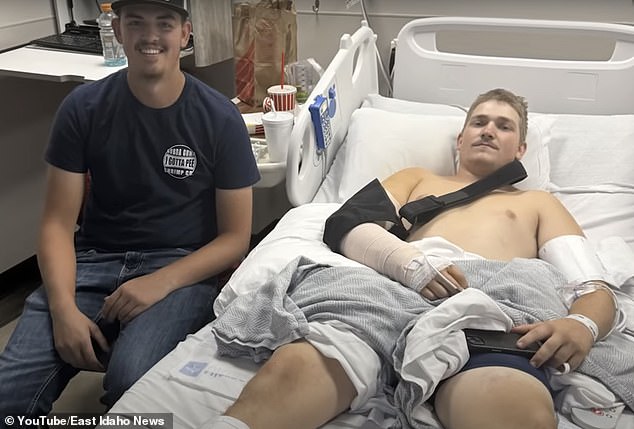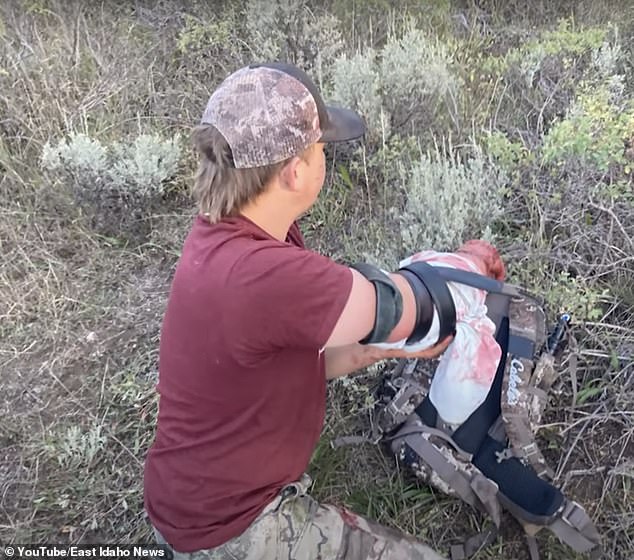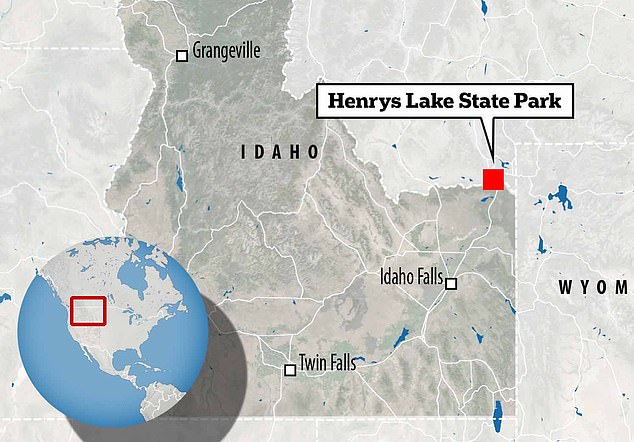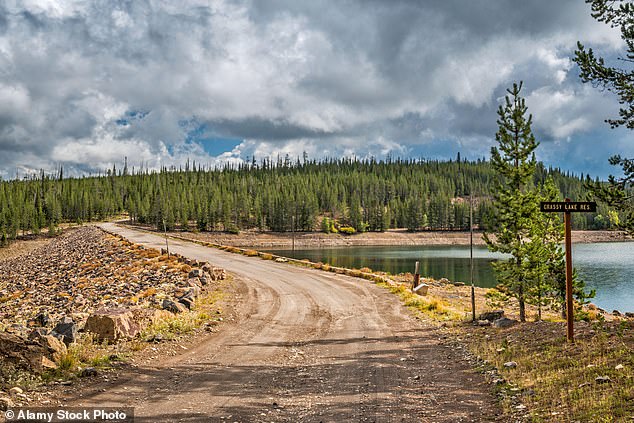I was tossed around by a 530lb Grizzly bear before friends saved my life by blasting it with 24 bullets: Video shows bloody aftermath of raging beast’s attack on elk hunters
An archer who was thrown and dangled from the jaws of a 550-pound grizzly bear miraculously survived the savage attack after he and his friend shot the beast with 24 bullets.
Riley Hill, 20, was hunting moose in the Caribou-Targhee National Forest, west of Henrys Lake in Island Park, Idaholast week, when the grizzly came out of nowhere and sank its teeth into his arm, piercing his skin and bone.
“It lifted me off the ground and then threw me back down,” Hill said Eastern Idaho News“It was like playing tug of war with your dog, but he was playing with my arm and tore it apart.”
Braxton Meyers, who was hunting with Hill, fired several shots at the 20-year-old male grizzly as he tossed his friend from side to side. Hill also managed to grab his rifle and fire at the animal. The pair fired 24 bear pellets at the grizzly before successfully taking him down.
Together with another friend, the duo walked out of the woods back to their vehicle, hoping that they could be rescued that way.
Hill was eventually airlifted to Eastern Idaho Regional Medical Hospital, where he received 40 staples and numerous stitches. He has since been released from the hospital, but doctors estimate it will take at least two months for his arm to heal.
This is the 530-pound grizzly bear that charged a pair of archers in the Caribou-Targhee National Forest and sank its teeth into one of their arms, piercing the hunter’s skin and bone. The bear died after the pair shot him 24 times

Riley Hill, 20, (right) was airlifted to Eastern Idaho Regional Medical Hospital, where he received 40 staples and numerous stitches. He has been released from the hospital, but doctors estimate it will take at least two months for his arm to heal. He is pictured with Braxton Meyers (left), who was with him during the attack
Hill and Meyers began their search on Sunday, September 1, shortly after dropping off two friends in the neighborhood around 7 a.m.
The pair parked their vehicle and began walking into the woods. Hill recalled being careful not to “spook anyone.”
He recalls stepping forward about 10 feet at about 7:20 a.m. when he heard a “loud thud,” followed by Meyers yelling, “Oh shit, that’s a bear!”
Meyers said the grizzly came toward him on all fours, at which point he ran away, hoping Hill could get his gun.
Hill, who was holding his bow, dropped the weapon, pulled a 10mm pistol from a holster on his hip and shot the bear in the side. Meyers reportedly stumbled and fell to the ground.
“Grizzlies usually don’t lose sight of their target, but this one did,” the hunter recalled. “This one turned, looked right at me, and he charged, fast.”
Hill managed to shoot the bear three times in the face and shoulder area before the bear sank its teeth into his arm and began swinging him around.
Meyers stood up, “rummaged around” and grabbed a gun. He fired four or five shots at the animal before his weapon jammed.

Hill, pictured with his injured arm after the attack, said the bear “picked me up off the ground and then threw me back down. It was like playing tug-of-war with your dog, but he was playing with my arm and tore it apart.”
“I had to pick my shots carefully,” Meyers explained, adding, “By that time the bear was on top of Riley and Riley’s shoulders were between him. [its] his front legs and his legs are kind of kicked out of his stomach. I couldn’t see what Riley was doing. I could just see the bear on him.’
Meyers said he then ran toward the bear and continued shooting. Hill stated he “felt the bullets hit the bear through my arm.”
Although Hill was not hit by the gunfire, he claims he could feel the “repercussion of the bullets hitting the bear.” He also recalled several bullets coming within “two to three inches” of his head.
Hill said the grizzly “looked up at me and I saw his eyes,” then started shooting, prompting him to “put his head back down.” He then shot him in the spine, which he said “did the trick.”
He then “ripped that jaw open, ripped my arm out” and stood up, unsure if the bear would go after him. He grabbed his rifle and fired more shots into the animal’s head.
After taking down the bear, Meyers attempted to tend to Hill’s wounds, wrapping a shirt around his arm and using their belts to create two tourniquets. He then called 911 and requested an ambulance or helicopter.

Riley Hill and Braxton Meyers were elk hunting near Henrys Lake in Island Park, Idaho — about 15 miles west of Yellowstone National Park — on Sunday, September 1 when they were attacked by an adult male grizzly bear. Hill was “knocked down and bitten by the bear” during the encounter
Meanwhile, Meyers’ younger brother Boone, 18, ran to the duo’s residence after hearing them screaming from miles away.
Boone, who was with the pair only 20 minutes before the attack, arrived on the scene seven minutes later.
He recalled: ‘All I saw was a huge bear lying on the ground. It was a wild, wild place, to be honest. They were awake, both alive, thankfully.’
The trio walked back to their vehicle on a trek that Hill described as “painful” and “one of the hardest climbs of my life,” with blood reportedly spurting from his wound every 15 steps or so.
They got into their vehicle, sped across a field and positioned themselves in a spot where a helicopter could land.
Hill was airlifted to a nearby hospital, treated and released the next day. Although he is fortunate the grizzly did not puncture any arteries, doctors say it will take several months for his arm to fully recover.
The hunters agree that they saved each other’s lives.
Idaho Fish and Game conducted a thorough investigation into the attack on Hill and Meyers, with Conservationists determined the pair acted in self-defense when they shot the grizzly.
“I am extremely grateful that these two individuals survived this encounter,” Regional Fish and Game Supervisor Matt Pieron said in a news release last week.
“I’ve had the chance to speak with the injured fighter and his family and they are truly wonderful people. I wish him a speedy recovery from his injuries and the trauma that these two fighters have gone through.”
While Hill and Meyers are grateful to be alive, they both say they are “sad” that the bear was killed.

An estimated 1,000 grizzly bears live in the Greater Yellowstone Ecosystem. Grizzly bears are protected under the Endangered Species Act, which means it is illegal to harm them unless in self-defense (File photo from Caribou Targhee National Forest)
An estimated 1,000 grizzly bears live in the Greater Yellowstone Ecosystem. Caribou-Targhee National Forest is located approximately 15 miles west of Yellowstone National Park.
Grizzly bears are protected under the Endangered Species Act, which means it is illegal to harm a grizzly bear unless it is in self-defense.
“Grizzly bears in the 48 contiguous states are currently protected as an endangered species. It is illegal to injure, harass, or kill these bears except in self-defense or the defense of others,” a U.S. Fish and Wildlife official told ABC News.
“Grizzly bear conservation is a complex process and is only possible through a variety of partnerships involving the Interagency Grizzly Bear Committee, state conservation organizations, Native American tribes, federal agencies, universities, and other organizations.”
